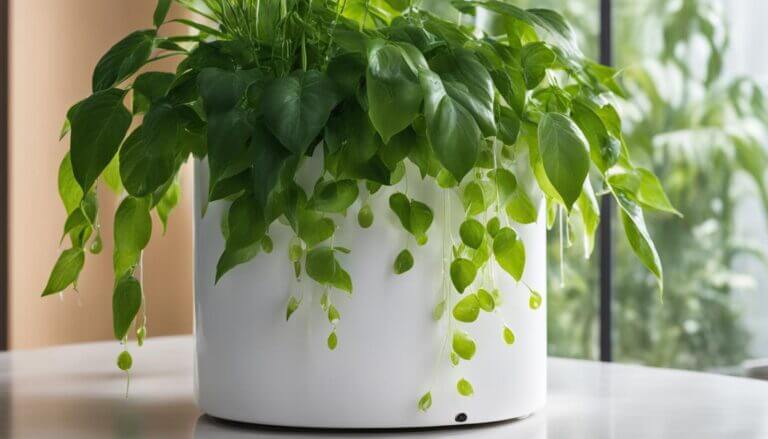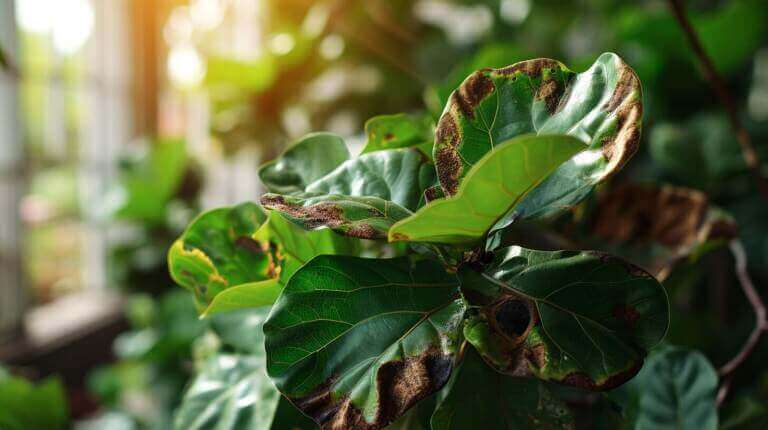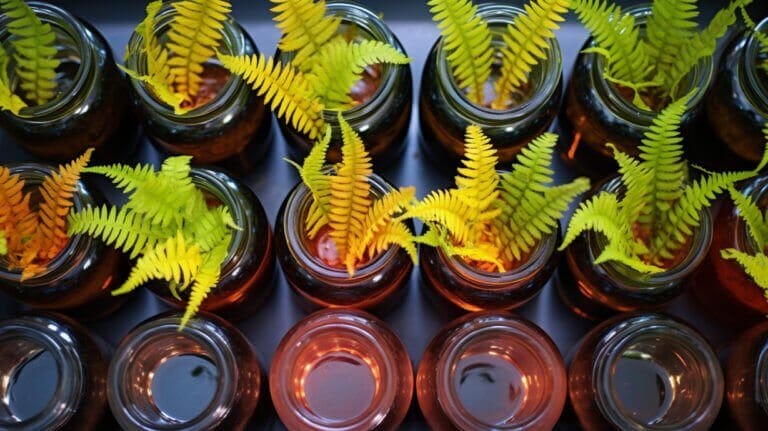Calathea Lancifolia Rattlesnake Plant Care Guide: Caring for Calathea Orbifolia And Other Varieties
Calathea plants, including the lancifolia, orbifolia, and rattlesnake varieties, are beloved by nature enthusiasts for their striking and contrasting color palettes. These tropical plants thrive in medium-high humidity and are perfect for home and bathroom decor. With over 300 recognized varieties, it can be overwhelming to choose the right one. But don’t worry, I’ve compiled a list of the most common and rarest Calathea types to help you care for these beautiful plants.
Key Takeaways:
- Calathea plants are known for their striking color palettes and contrasting foliage.
- These tropical plants thrive in medium-high humidity and make excellent home and bathroom decor.
- There are over 300 recognized varieties of Calathea, including the popular lancifolia, orbifolia, and rattlesnake varieties.
- Caring for Calathea requires specific care instructions to ensure lush growth and vibrant foliage.
- Stay tuned for the upcoming sections on caring for specific Calathea varieties, including the rattlesnake plant, medallion, peacock plant, and rare Calathea types for your indoor garden.
Calathea Lancifolia (Rattlesnake Plant)
The Calathea Lancifolia, commonly known as the Rattlesnake Plant, is a popular choice among plant enthusiasts due to its unique appearance and relatively easy care requirements. This Calathea variety features deep-green leaves adorned with elliptical circles and a light green background, giving it a striking resemblance to the skin of a rattlesnake. Its reptile-like markings make it a fascinating addition to any indoor space.
When it comes to caring for the Calathea Lancifolia, it prefers medium to bright indirect light. Direct sunlight should be avoided as it can cause the leaves to scorch. This plant also thrives in a humid environment, so it’s important to maintain a moderate level of humidity around it. Regular misting or placing it on a tray filled with water and pebbles can help increase humidity levels.
Watering the Rattlesnake Plant can be a bit tricky. It’s important to keep the soil consistently moist but not soggy. Allow the top inch of soil to dry out before watering again. Overwatering can lead to root rot, while underwatering can cause the leaves to curl and become dry. Use distilled or filtered water as tap water containing chlorine and fluoride can damage the plant. To enhance moisture, you can also place a pebble-filled tray under the pot and keep it filled with water.
Table: Calathea Lancifolia Care Tips
| Light | Watering | Humidity | Temperature |
|---|---|---|---|
| Medium to bright indirect light | Keep soil consistently moist, but not soggy | Maintain moderate humidity levels | 60-80°F (15-27°C) |
| Avoid direct sunlight | Allow top inch of soil to dry out before watering | Mist regularly or use a pebble tray for added humidity | Avoid temperatures below 55°F (13°C) |
The Calathea Lancifolia can be a wonderful addition to your indoor plant collection. Its unique appearance and relatively easy care make it a great choice for both beginners and experienced plant enthusiasts. With proper care, this plant can thrive and bring a touch of natural beauty to your home.
Calathea Roseopicta ‘Medallion’
Calathea roseopicta ‘Medallion’ is a stunning variety of Calathea known for its glossy forest green leaves with deep purple undersides. This cultivar features a unique layering motif on the leaves, creating an exquisite outline pattern that adds to its visual appeal. Unlike some other Calathea varieties, ‘Medallion’ is less prone to developing brown leaf tips, making it a popular choice for plant enthusiasts.
Caring for Calathea roseopicta ‘Medallion’ requires attention to its specific needs. Here are some essential care tips to ensure the optimal growth and beauty of this beautiful plant:
- Light: ‘Medallion’ prefers bright indirect light. Avoid direct sunlight, as it can scorch the leaves.
- Temperature: Maintain a temperature range of 65-80°F (18-27°C). Avoid exposure to cold drafts or sudden temperature fluctuations.
- Humidity: Calathea roseopicta ‘Medallion’ thrives in high humidity. Mist the leaves regularly or place the plant on a pebble tray filled with water to increase humidity levels.
- Watering: Keep the soil consistently moist but not soggy. Water thoroughly when the top inch of soil feels dry, and ensure proper drainage to prevent waterlogging.
- Soil: Use well-draining potting soil with a mixture of peat moss, perlite, and vermiculite.
- Fertilization: Feed ‘Medallion’ with a balanced houseplant fertilizer every two to four weeks during the growing season.
- Pruning: Trim any yellowing or damaged leaves to maintain the plant’s overall health and appearance.
With proper care, Calathea roseopicta ‘Medallion’ can thrive and become a stunning addition to your indoor garden. Its unique foliage pattern and vibrant coloration are sure to captivate any plant lover.
| Light | Temperature | Humidity | Watering | Soil | Fertilization | Pruning |
|---|---|---|---|---|---|---|
| Bright indirect light | 65-80°F (18-27°C) | High humidity | Keep soil consistently moist | Well-draining potting soil | Feed every 2-4 weeks | Trim yellowing or damaged leaves |
Calathea Makoyana (Peacock Plant)
Calathea makoyana, also known as the peacock plant, is a stunning variety of Calathea that adds a touch of tropical elegance to any indoor space. With its beautiful deep green foliage adorned with wavy, shiny, and silver streaks, this plant truly resembles the feathers of a peacock. The intricate patterns on its leaves make it a visually captivating addition to your home.
When it comes to caring for Calathea makoyana, maintaining the right growing conditions is key. This plant thrives in medium to bright indirect light, so placing it near a window with filtered sunlight is ideal. It’s important to keep the soil consistently moist but not soggy, as overwatering can lead to root rot. Humidity is also essential for the peacock plant, so misting the leaves regularly or placing a tray of water near the plant can help create the right environment.
Additionally, Calathea makoyana appreciates warmth and temperatures between 65-80°F (18-26°C). Avoid exposing it to drafts or sudden temperature changes, as this can cause stress to the plant. As for fertilizing, a balanced houseplant fertilizer applied once a month during the growing season can provide the necessary nutrients.
Overall, Calathea makoyana is a relatively low-maintenance plant that can thrive in the right conditions. With its striking foliage and tropical vibes, it’s sure to be a standout among your indoor flora collection.
Rare Calathea Varieties for Indoor Garden
Are you an indoor gardening enthusiast looking to add a touch of uniqueness to your collection? Look no further than rare Calathea varieties. These elusive beauties are highly sought after by plant lovers for their stunning foliage patterns that can truly elevate the aesthetic of any indoor garden.
One such rare Calathea variety is the Calathea Lietzei, also known as the White Fusion Calathea. With its vibrant green and white marbled leaves, this plant is a showstopper. It requires a bit of extra care compared to more common Calathea varieties, including bright indirect light and regular misting to maintain its stunning appearance.
Calathea Ornata
The Pinstripe Calathea, or Calathea Ornata, is another rare gem that will steal the spotlight in your indoor garden. Its deep green leaves are adorned with bright pink stripes, adding a pop of color and personality to any space. To care for this beauty, provide it with bright indirect light and keep the soil consistently moist, but not soggy.
Calathea Beauty Star
For those looking for a unique leaf shape, the Calathea Beauty Star is the perfect choice. Its elongated, lance-shaped leaves feature striking patterns of dark green, pink, and white, creating a mesmerizing display. To keep this rare Calathea thriving, place it in bright indirect light and maintain a regular watering schedule.
Calathea Warscewiczii
The Jungle Velvet Calathea, or Calathea Warscewiczii, is a true masterpiece. Its velvety, dark green leaves with deep purple undersides make it a stunning addition to any indoor garden. This rare Calathea thrives in medium to low light conditions and requires consistently moist soil to flourish.
Caring for these rare Calathea varieties requires attention to their specific needs. Remember to provide them with the right amount of light, water, and humidity to ensure their optimal growth and beauty. These plants are sure to be the centerpiece of your indoor garden, captivating both your eyes and your guests’ attention.
FAQ
What is the basic plant care for a Calathea Lancifolia?
Calathea Lancifolia, also known as the Rattlesnake plant, prefers indirect filter light, high humidity, and well-draining potting mix. It should be watered when the top inch of soil is dry.
How often should I water my Calathea Lancifolia plant?
You should water your Calathea Lancifolia when the top inch of soil is dry. Overwatering can lead to root rot. Using distilled water can prevent mineral buildup in the soil.
What are some tips for Rattlesnake plant care?
The Rattlesnake plant prefers high humidity, which can be achieved by placing it near a humidifier or misting the leaves. It also prefers indirect sunlight and well-draining soil.
How do I maintain the right humidity for my Calathea plant?
Calatheas, including the Rattlesnake plant, prefer high humidity. This can be achieved by placing the plant near a humidifier, misting the leaves, or placing the pot on a tray of pebbles filled with water.
Can I keep my Calathea Lancifolia as a houseplant?
Yes, Calathea Lancifolia makes a great houseplant. It’s known for its striking foliage and can thrive indoors with the right care.
What is the Calathea Rattlesnake plant?
The Calathea Rattlesnake plant, or Calathea Lancifolia, is a variety of Calathea known for its unique, patterned leaves that resemble the scales of a rattlesnake.
How do I keep my rattlesnake calatheas plant healthy?
To keep your Rattlesnake plant healthy, provide it with indirect light, high humidity, and well-draining soil. Regularly check for signs of pests like spider mites, and remove any yellow or brown leaves.







